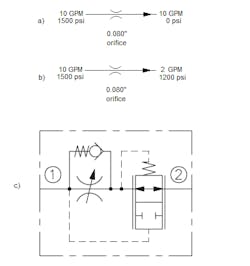Tip #15 — The Ferrari must be compensating for something
This file type includes high resolution graphics and schematics when applicable.
For anyone who is or was a technician working on any type of hydraulic equipment, you quickly became proficient at keeping that gear running like well oiled machines. I was one of those technicians; I could replace the hell out of a valve, swap a gerotor like it’s going out of style or get-my-oil-change-on. However, I didn’t really understand how it all worked. I had an idea how it all worked, but it was about as in-depth as my current knowledge of quantum physics (Electrons can be in two places at once? My mind is blown!)
I was lucky to have my hydraulic door opened by none other than Princess Auto, the Canadian retail chain selling everything including air compressors, trailer equipment, tools and — you guessed it — hydraulic parts and systems. They are a generous and progressive outfit, and their training programs are extensive, especially the hydraulic leg.
I was hired by them specifically to work in their hydraulics section, and was fortunate enough to be shipped off to Winnipeg for my first two weeks of hydraulic training. Besides gaining ten pounds from complimentary food, I gained a massive amount of knowledge of fluid power. It was quite overwhelming, but left me craving more. One of the hydraulic concepts I had a hard time with initially was “pressure compensation.”
Everyone has heard the terms: “pressure compensated this,” or “pressure compensated that.” Ya got yer pressure compensated flow control, yer pressure compensated pump and even yer straight up pressure compensator. What does it all mean? Well, “ya” means you and “yer” means your.
However, if we add load-induced pressure downstream of the orifice like in example b), we change the pressure differential across the orifice. In this case, we have 1200 psi of load pressure, leaving only 300 psi of “potential” to flow across the orifice. The differential pressure is simply the difference between the pressure at the inlet and outlet of the flow control (or orifice). Now, we flow only 2 gpm. Essentially the load is pushing backward on the fluid entering the orifice, slowing down its movement.
These first two are examples of non-pressure compensated flow control. For example c) I’m showing a symbol HydraForce uses for their FR50-23 Pressure Compensated Flow Regulator. As you can see, a lot of it is similar to a standard flow control symbol. The check valve means it flows freely from port 2 to port 1, but will “meter” when flowing from port 1 to port 2, because the check valve forces flow through the restriction.
The diagonal arrow means the flow rate is variable. The part most of you are confused by is the double-square symbol with the dashed lines coming out of the top and bottom. That is a pressure compensator. I challenge you to stop reading, spend some time looking at the symbol and tell me what would happen if pressure was maintained at port 1, but would rise at port 2.
If you figured it out, mad props to you! If not, I’ll break it down for you. The dashed lines are “pilot lines.” They are small drillings or holes that transmit hydraulic energy from one spot to another. In this case, the pressure signal from just before the flow control (orifice) is being fed to the bottom of the compensator. Conversely, there is another pressure signal after the flow control that is being fed to the top of the compensator.
The two lines running up and down parallel to the valve mean it is infinitely variable between its range of motion (you see these lines on proportional valves, for example). The spring tells us it is biased to one side so that when it loses pilot pressure it will spring back to fully open. The bidirectional arrow means you can flow both directions through the valve, and the sideways T shapes mean flow will be blocked (or partially blocked) if pilot pressure from the bottom forces the valve closed.
If there is flow, but little pressure at port 1 and little pressure at port 2, nothing much happens; it simply flows through itself whatever oil is being fed to port 1. If we start to close the flow control (restricting flow through the variable orifice), pressure will rise at port 1 and will work down the bottom pilot line and start to close the pressure compensator a little bit. It’s OK that the pressure compensator closes a bit because it’s proportional to the flow control setting (i.e., the compensator won’t choke pressure any more than is already choked by the flow control).
However, at any point in which pressure rises downstream of the flow control (anywhere from the flow control output to port 2), you can see that the top pilot line will be affected also. Pilot energy will then start pushing the compensator further open, increasing flow energy to port 2 to counteract the load pressure pushing back on the flow control. It will open itself exactly equal and opposite to the downstream energy trying to reduce flow through the flow control due to reduced pressure differential.
The other reference to pressure compensation is variable displacement pumps. In the case of pressure compensated pumps, the pump is designed to provide a variable flow rate at a pre-set pressure. So instead of maintaining flow regardless of downstream pressure, the pump will maintain that pre-set pressure without mind of load pressure. It does this by varying its flow output.
I won’t get in to the details of how the pump works (that’s an article unto itself), but the pump always tries to flow as much as it can (within the limitations of its displacement and speed). At any point in which the pressure at the pump is less than the pump’s compensator setting, it will be providing full flow. The pressure compensator is a relief valve for the bias piston (the piston that tries to keep the pump at full stroke).
As flow is metered/throttled/controlled/restricted/choked downstream of the pump, the volume of the pump will be reduced also. The reduction in flow is proportional to the compensator setting’s value of pressure drop across that downstream flow control. For example, if the compensator setting is 1000 psi, the flow of the pump will exactly match the flow across the flow control equal to that 1000 psi. More pressure equals more flow or a larger orifice equals more flow. In a nutshell, the pump will compensate for downstream changes in flow by increasing or decreasing displacement to maintain the preset pressure.
This file type includes high resolution graphics and schematics when applicable.


